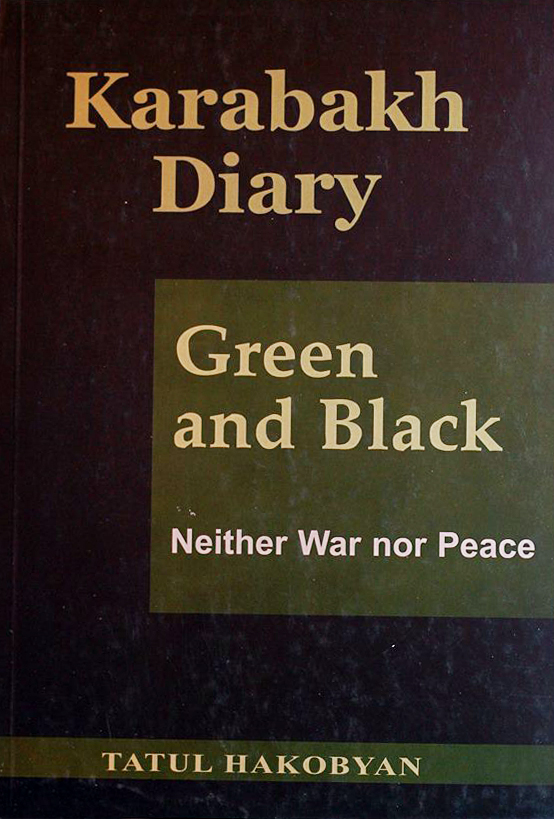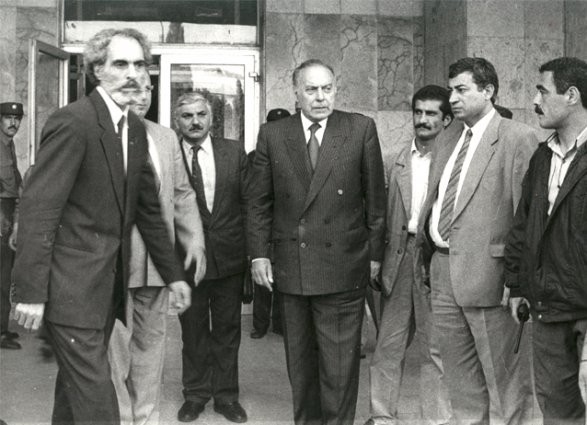A chapter from KARABAKH DIARY by Tatul Hakobyan
On July 7, 1992, Abulfaz Elchibey, head of the Popular Front won the Azerbaijani presidential elections with over 60 percent of the votes.
Elchibey’s formula for the resolution of the NK conflict was to deport all Armenians in NK; an assignment he believed could become reality with the help of the national army.
“If even one Armenian is still in NK after October of this year, the people of Azerbaijan can hang me in the central square in Baku”, he promised. During other events he boasted of drinking tea in Stepanakert and washing his feet in the waters of Sevan. Unlike Russian-oriented Mutalibov, Elchibey was anti- Russians and was Turkish-oriented. Even during negotiations in Moscow, he avoided speaking Russian and communicated with the help of a translator. He did not hide his anti-Iranian rhetoric and considered Tabriz the capital city of a united Azerbaijan.
Five days after the presidential elections, from June 12 to 15, Azerbaijani military forces massively attacked and seized the entire region of Shahumian, several towns in Askeran and Martakert. The Armenian President received news of the counter-attack in Rio de Janeiro, where he was participating in a conference.
On June 13 Ter-Petrossian’s announcement was circulated, “Armenia resolutely protests Azerbaijan’s attack and is appealing to the international community to immediately take measures to stop the massive attack against NK and avoid new human losses and destruction. If international pressure to restrain Azerbaijan is delayed, Armenia will have no other choice but to take decisive actions and offer the necessary help and support to defend the rights and security of the people of NK.” On June 14 Ter-Petrossian met with President Bush, Prime Minister Demirel and the Deputy President of Iran, Habibi.
Azerbaijan’s attack was not unexpected. Serge Sargsyan, the Head of NKR’s Defense Committee clarified, “We knew that sooner or later the enemy would make such an attack. It would not be true if we said that we had not prepared. Unfortunately, we did not succeed in confronting that huge force. 150 units of military equipment and several thousand infantry participated in that attack. Azerbaijan had received a large quantity of equipment from the CIS army.” Sargsyan noted another reason for the defeat, “After Shushi and Lachin, there was kind of a festive mood and many believed that they had done their share of fighting and that new conscripts should continue the fight”.
Arkady Ter-Tadevosyan insists, “In Martakert we were fighting against the Russians. Hungry officers of the Soviet army were left in Gyanja. They reached Martakert with tanks and suddenly turned around and left, leaving us to the Azerbajianis”.
Elsewhere, Ter-Tadevosyan had also numerated other reasons for the defeat. Primarily he has noted the delay in creation of the armed forces in Armenia, the inflexible political confrontation between the Armenian National Movement and the ARF Dashnaktsutyun, the festive mood amongst the Armenian forces after the victories in Shushi and the opening of the Lachin corridor, the drop in fighting spirit and the panic and lack of detailed intelligence.
“The political leadership in Armenia and Artsakh were busy struggling for power and they did not take necessary measures to strengthen Artsakh’s defenses. In this regard, Armenia’s political and military authorities are the first to be blamed, because they controlled those means (units, weapons and arms), which had to be sent to strengthen Artsakh’s defenses. The Defense Command of Martakert did not receive necessary help from either Stepanakert or Armenia. Prior to the fall of Martakert on July 4, out of the nine self-defense battalions only AshotGhulian’s first battalion participated in the defense of the Martakert region”, writes Ter-Tadevosyan.
Victory has its master, sometimes many, but defeat is an orphan. This national saying is true for the Shushi-Lachin victory and the Shahumian-Martakert defeat. When the NK forces and civilians fled the southern regions of Artsakh in panic, Armenia and its authorities were also to blame in this defeat, but when it liberated Sushi, it exerted all efforts to show that Armenia did not send military aid.
For the Shahumian and Martakert defeat Samvel Babayan emphasizes the lack of arms. “In February 1992, the entire arsenal of the former USSR fourth army was handed to Azerbaijan. While Azerbaijan was busy with that, we unexpectedly started and successfully concluded the Shushi operation. However, we lacked armor. Only in August did Armenia receive a part of the former USSR seventh army’s arsenal. Azerbaijan’s, and sometimes even Armenia’s, assertions, that during the years of the conflict the Russians helped Artsakh and Armenia more are not true. There are documents. Have a look at them and see for yourself when and what was received by whom. The main reason for our defeat in that phase was the lack of armaments.”
Tashkent: the Soviet arsenal gets divied up
On May 14, 1992, the presidents of Armenia and Azerbaijan were occupied with completely different issues. In Tashkent, Ter-Petrosyan was discussing issues connected with the status of the CIS armed forces and their future with the leaders of the five CIS countries – Russia, Belorussia, Uzbekistan, Kazakhstan and Turkmenistan. In Baku, Mutalibov had return to power for a single day. On May 15, the Collective Security Treaty (CST) was signed in the capital city of Uzbekistan and the Soviet arsenal was distributed among the CIS countries. As to which country inherited how much from the Soviet armory remains contradictory and debatable.
Earlier, Ter-Petrosyan had circulated a special announcement, which proposed putting the issue of the illegal handing over of arms from the Fourth Army of the CIS United Armed Forces to Azerbaijan at the top of the CIS March 20th summit’s agenda. “From the beginning of 1992, the reserves of the Trans- Caucasian Military Unit, which contained armaments with the force of up to 8 megatons, were placed at the disposal of Azerbaijan’s national army – more than fifty S-72 tanks, more than a hundred military vehicles, dozens of high- caliber artillery stations, including BM-21 Grad stations, nine military fighter helicopters and other military equipment including weapons and ammunition. All that equipment, obtained without a single firing or fighting by soldiers, was immediately transported to NK and used to physically annihilate its native people.”
In his memoirs, Vladimir Stupishin, the first Russian Ambassador to Armenia quotes part of his conversation with Ter-Petrosyan on June 20, 1992. The president mentions that he is worried about Moscow’s stance on arming Azerbaijan. “Having received a large quantity of tanks and other armaments, the Azerbaijanis have attacked NK. They use Russian mercenaries during the battles and it is they who bomb Stepanakert. The people of Armenia, who would like to continue seeing Russia as its ally in the future, view this negatively.”
Armenia received its share of the Soviet arsenal later. VahanShirkhanyan participated in the process of handing over the property of the Seventh Army to Armenia. “Grachov signed the directive in May, 1992. By that time Azerbaijan had literally appropriated the Soviet arms, ammunition and military equipment within its territory. Until the signing of the directive relations were very tense and even hostile. They [the Russians] were trying to take the arms, ammunition and equipment out of Armenia, circumventing the president’s order that the appropriate bodies must be informed. After the signing of the directive, we took the assets of two divisions out of Russia’s three, leaving one for them. That became the foundation for Gyumri’s 102nd Military Base. We have always been inferior as far as air power is concerned since Armenia did not have an air force, but Azerbaijan had two very good military airports with numerous helicopters.”
NK also received something from the Soviet arsenal. The people of NK resisted the removal of the 366th motorized artillery regiment from Stepanakert. On February 28, 1992, Yevgeny Shaponshnikov, the Chief Commander of the CIS Joint Armed Forces, sent a telegram to Mutalibov and Ter-Petrosyan. The telegram said that the situation in NK “shows no sign of peaceful settlement and the criminal acts of appropriation of equipment, arms and ammunition were accompanied by the deaths and injury of innocent people”. Shaponshikov ordered the withdrawal of the 366th Regiment from NK.
In order to ensure the withdrawal of the 366th Regiment from Stepanakert, a large number of CIS paratroopers were brought in. The people of NK considered Shaponshikov’s order untimely, taking into consideration the fact that Azerbaijan’s army was well-equipped from the Soviet arsenal.
The roads were blockaded the local armed groups and people. The transportation of a part of the personnel to Gyanja was possible. In the early morning of March 3, during an attack on one of the battalions of the regiment, one paratrooper was killed. The armed groups occupied the military town left by the army.
On January 1994, Robert Kocharyan said that in NK they are primarily fighting with the equipment left to Azerbaijan and Armenia by the Soviet Union. “We were lucky because there were three military units scattered in the territory of NK and we obtained those arms. Those were Soviet arms. Azerbaijan received 2-3 times more weaponry than Armenia, because more armaments were based in its territory. According to the agreement, we had to hand those armaments to Azerbaijan, but we did not let that happen. We had expropriated those weapons. There was an attempt to remove them. They brought in the paratroopers and generals had come, but we had safely blockaded it. Furthermore, we considered that was our share from the Soviet arsenal, which NK legitimately earned over 70 years.”
To the Russian journalist’s question, “Is anything being brought from Armenia?” Kocharyan answered, “Armenia has truly given us air-defense equipment. And so, we managed to relatively secure NKR from Azerbaijan’s air force”.
Ter-Petrosyan personally applied to Yeltsin in a written letter asking for supplies of arms. Since Azerbaijan had received more from the Soviet military arsenal than Armenia, the President of Russia wanted to ensure the balance. The good relations between Ter-Petrosyan and Yeltsin and Vazgen Sargsyan and Pavel Grachov were important. Ter-Petrosyan argued that, “All the stories that the Russians helped the Armenians more is a legend; it’s nonsense. The Russians behaved very honestly and preserved a balance.”
“It turned out that there were three times more weapons in Azerbaijan than in Armenia. And when we talked to the Russian side, we came to the conclusion- and I managed to get them to agree to this-that we should be compensated for this. Yeltsin agreed to this and agreed that the balance had to be preserved. No more than a balance. In the following years-1992, 1993, 1994-we were almost completely compensated for the gap between us and Azerbaijan. And in 1994, we were on the same level. That means equipment, tanks, artillery, APCs, handheld weapons.”
In the winter of 1993, Vazgen Sargsyan confessed, “I can present the Russian intelligence data which shows how much arms and ammunition was received by Azerbaijan and how much by Georgia and Armenia. If we had published the data [of which only the president of the republic and I were aware] a year ago, the nation’s heart would have exploded from despair. For six-seven months we fought against four divisions with only one and a half divisions; we fought with twenty times fewer weapons.”
In 1997, General Lev Rokhlin presented a report to the Russian Duma maintaining that Moscow had supplied Armenia with about one billion dollars worth of armaments (720 million of which is the value of the arms, about 300 million, transportation costs and spare parts). The majority of heavy armed machinery was delivered after the war from 1995-1996. According to Rokhlin’s report, from August 1992 onwards, the Armenian side had received ammunition from the military base depot in Mozdok, a city in North Ossetia.














